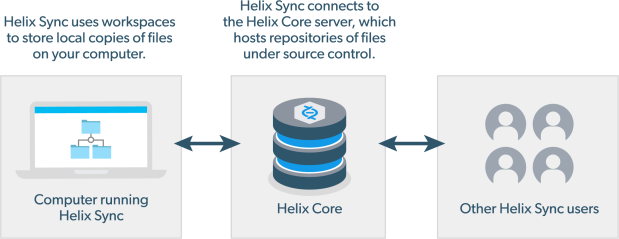How P4 Sync works
P4 Server provides a central storage area for all of your shared assets. All of the files on the P4 Server are version controlled and accessible by P4 Sync. P4 Sync lets you upload and download files to P4 Server or P4 DAM and shows when new versions of files are available for you.

Basic P4 Sync workflow
-
P4 Sync notifies you if there are newer versions of files on the P4 Server. Download files you need to your workspace. See Download changes.
-
Add, edit, rename, and delete files in your workspace as you normally do when working on a project. See Work with files in your workspace.
-
Upload the files to the P4 Server using P4 Sync. See Upload changes. Your uploaded files are available to the other P4 Sync users connected to the P4 Server.
Downloading and uploading files regularly can help to minimize file conflicts with other P4 Sync users.
Use P4 Server or P4 DAM
You can choose to either use P4 or P4 DAM to store your files.
P4 Server is recommended if you already use Perforce workspaces and you are able to create new workspaces. If you are already familiar with P4 Server, you may prefer to use that. To use P4 Server, see Use P4 Sync with P4 Server.
P4 DAM is recommended if your administrator has deployed a P4 DAM instance in your organization. P4 DAM provides a simplified workflow that lets you work with P4 DAM projects and collections. No knowledge of P4 Server is needed. To use P4 DAM, see Use P4 Sync with P4 DAM.
Terminology
- Conflict: Conflicts can occur when two users edit and try to submit two versions of the same file to the P4 Server.
- P4 Server: The application that manages the revisions of your assets. Also known as P4 Server or P4D.
- P4 DAM: P4 Digital Asset Management (DAM) is a web-based interface that streamlines and secures the process of finding, reviewing, using, repurposing, and sharing assets.
- P4 Visual Client (P4V): A desktop application that provides access to versioned files on the P4 Server through a graphical interface. P4V can be used to set up your P4 Sync workspaces.
- Workspace: The folder on your computer where you work with your copies of assets in files and folders managed by P4 Server.